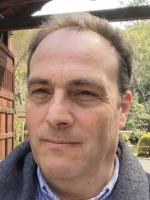
Career
- 2018-date: Royal Society E.P. Abraham Professor, DAMPT, Cambridge
- 2011-date: Herchel Smith Chair in Physics, Cavendish Laboratory,
- Cambridge
- 2002-2010: Personal Chair in the Theory of Condensed Matter, Cavendish Laboratory,
- Cambridge
- 2000-2002: University Readership in the Theory of Condensed Matter, Cavendish Laboratory, Cambridge
- 1995-1999: Lecturer, Cavendish Laboratory, Cambridge
- 1995-date: Fellow, St John’s College, Cambridge
- 1994-1995: Royal Society Research Fellow and Lecturer, Imperial College, London
- 1990-1991: Junior Research Fellow, Gonville and Caius College, Cambridge
Research
Ben is a member the Department of Applied Mathematics and Theoretical Physics and the Cavendish Laboratory, Department of Physics. He also holds affiliated positions in the Wellcome Trust/CRUK Gurdon Institute and the Wellcome Trust/MRC Stem Cell Institute. His research interests have spanned a wide range of topics within the area of theoretical quantum condensed matter physics. However, his current interests are focussed on the application of modelling approaches to study the dynamics of biological systems, from subcellular processes, to cell fate decision-making and morphogenic processes. His research is supported by grants from EPSRC, the Wellcome Trust, CRUK and the Royal Society.
Selected Publications
- S. Rulands, et al., Universality of clone dynamics during tissue development, Nature Physics 14, 469-474 (2018)
- E. Hannezo, et al., A unifying theory of branching morphogenesis, Cell 171, 242-255 (2017)
- X. Lan, et al., Cell fate mapping of human glioblastoma reveals an invariant stem cell hierarchy pre- and post-treatment, Nature 549, 227-232 (2017)
- A. Sanchez-Danes, et al., Defining the clonal dynamics leading to tumor initiation, Nature 536, 298-303 (2016)
- B. D. Simons and H. Clevers, Strategies of stem cell self-renewal in adult tissues, Cell 145, 851-862 (2011)
- C. Lopez-Garcia, et al., Intestinal stem cell replacement follows a pattern of neutral drift, Science 330, 822-825 (2010)
Publications
Identity and dynamics of mammary stem cells during branching morphogenesis
– Nature
(2017)
542,
313
(doi: 10.1038/nature21046)
Extensive Proliferation of a Subset of Differentiated, yet Plastic, Medial Vascular Smooth Muscle Cells Contributes to Neointimal Formation in Mouse Injury and Atherosclerosis Models.
– Circ Res
(2016)
119,
1313
A single dividing cell population with imbalanced fate drives oesophageal tumour growth.
– Nature cell biology
(2016)
18,
967
(doi: 10.1038/ncb3400)
Tracing cellular dynamics in tissue development, maintenance and disease
– Curr Opin Cell Biol
(2016)
43,
38
(doi: 10.1016/j.ceb.2016.07.001)
Defining the clonal dynamics leading to mouse skin tumour initiation.
– Nature
(2016)
536,
298
(doi: 10.1038/nature19069)
Dynamic heterogeneity as a strategy of stem cell self-renewal
– Proc Natl Acad Sci U S A
(2016)
113,
7509
(doi: 10.1073/pnas.1602779113)
Inhibition of β-catenin signalling in dermal fibroblasts enhances hair follicle regeneration during wound healing.
– Development (Cambridge, England)
(2016)
143,
2522
(doi: 10.1242/dev.131797)
Quantitative lineage tracing strategies to resolve multipotency in tissue-specific stem cells
– Genes and Development
(2016)
30,
1261
(doi: 10.1101/gad.280057.116)
2D and 3D Stem Cell Models of Primate Cortical Development Identify Species-Specific Differences in Progenitor Behavior Contributing to Brain Size.
– Cell Stem Cell
(2016)
18,
467
(doi: 10.1016/j.stem.2016.03.003)
The ciliary marginal zone of the zebrafish retina: clonal and time-lapse analysis of a continuously growing tissue.
– Development (Cambridge, England)
(2016)
143,
1099
(doi: 10.1242/dev.133314)
- <
- 13 of 30
